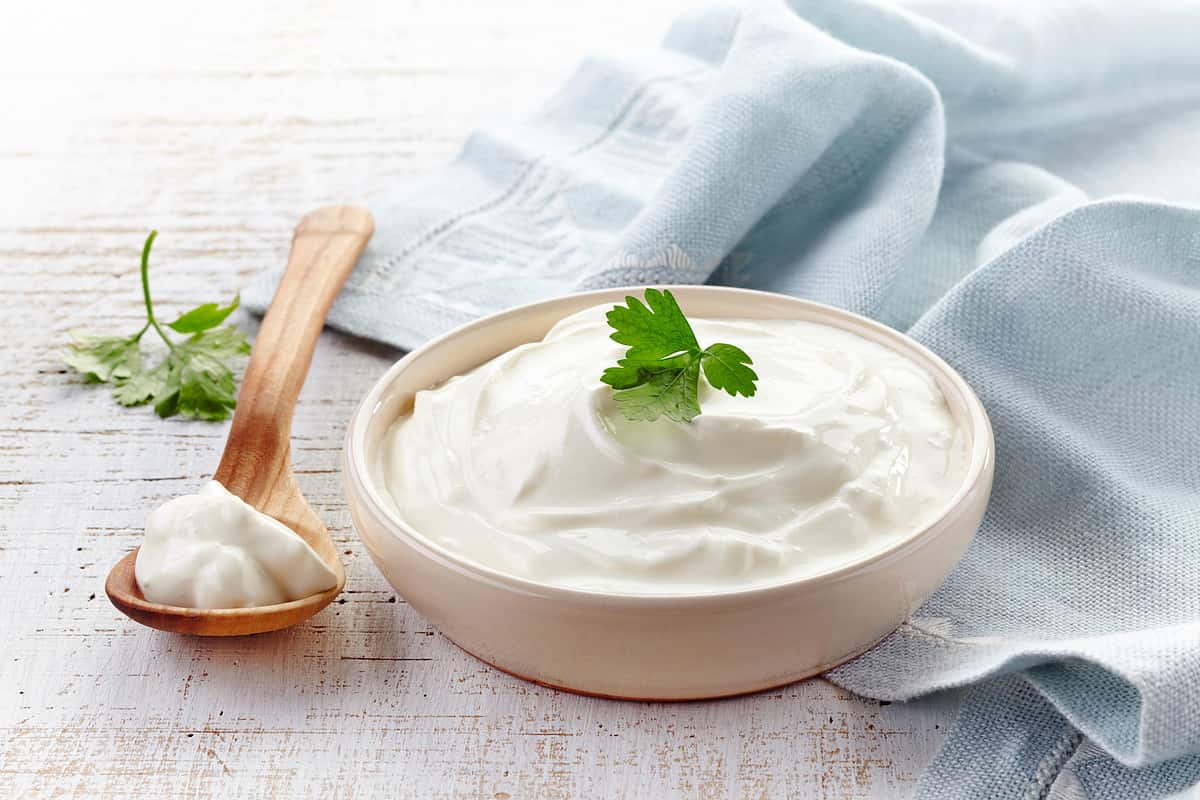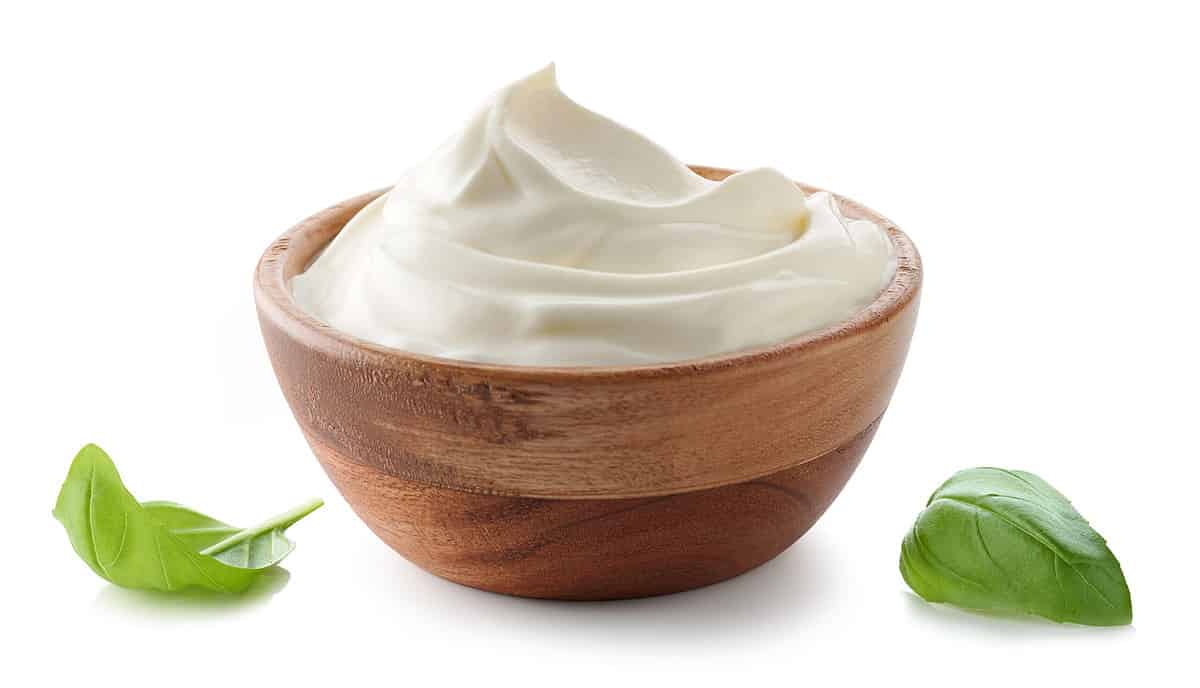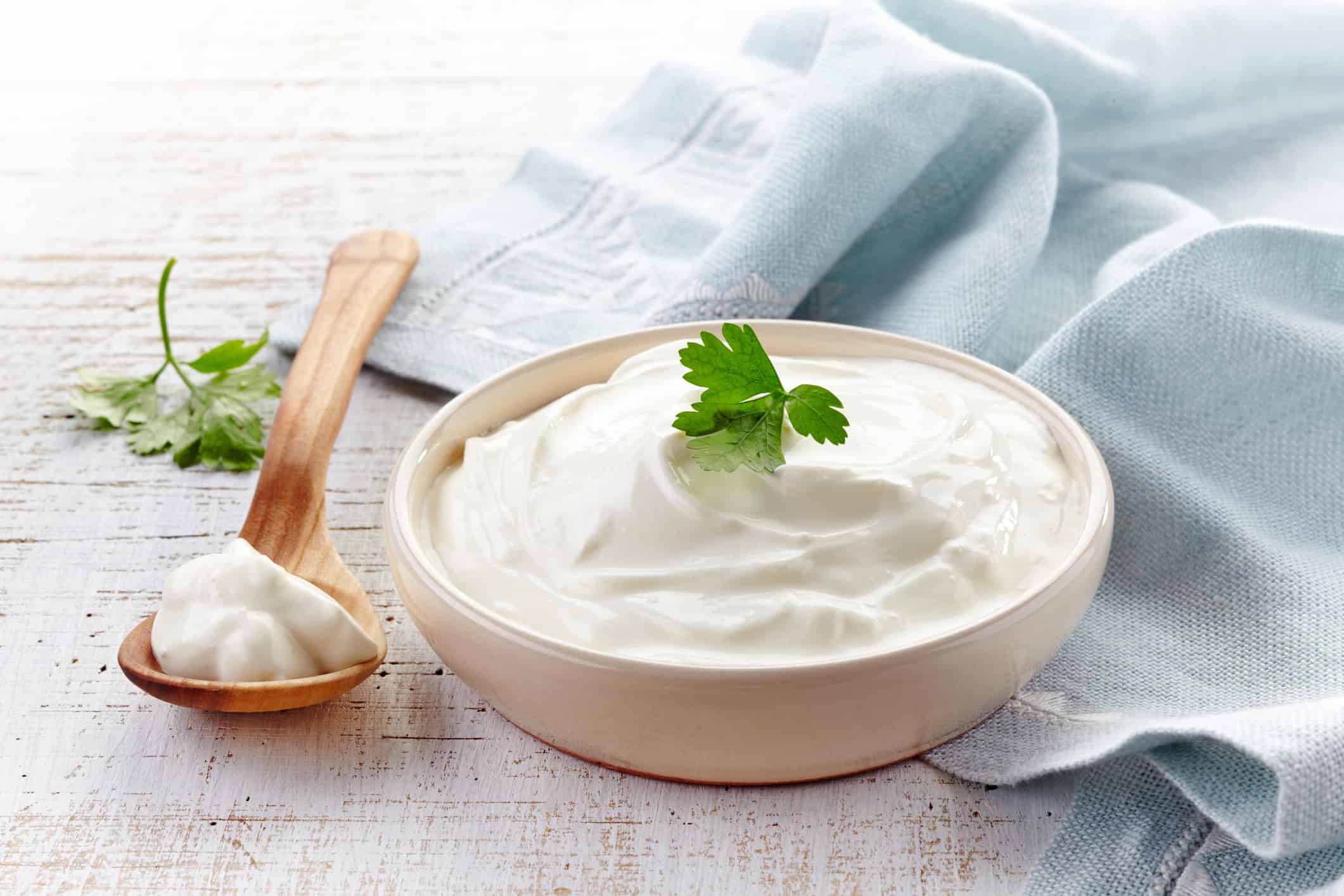Sour cream is a delicious, common dairy component used in various sauces and dips; it is also added as a topping to nachos and baked potatoes. Sour cream adds a tangy flavor to recipes. It is made by fermenting ordinary cream with particular types of lactic acid bacteria (LAB). This bacteria is beneficial to the stomach and balances the natural fluids within the stomach. Bacterial cultivation is introduced naturally or purposefully, and this thickens and sours the cream. There are advantages and disadvantages to eating sour cream; however, it can still be enjoyed while maintaining a healthy, balanced diet. In this article, we will discuss the history, nutritional values, health benefits, disadvantages, different types, and how you can make sour cream at home.

©iStock.com/Magone
The History of Sour Cream
It is believed that the Botai people, now known as Kazakhstan, were the first to ferment mare’s milk, known as koumiss, which resulted in the creation of sour cream. This became a staple of the Mongolian nomadic tribes. Raw mare’s milk has a strong laxative effect on humans. This is because it has more lactose than yak’s or cow’s milk. The process of fermentation drops the lactose levels when the microbes convert to lactic acid.
Is Sour Cream Healthy?
There are various health benefits to eating sour cream; however, the main advantage comes from the probiotics. The good live bacteria in the stomach are known as probiotics. Probiotics are found in fermented foods such as kombucha, sourdough bread, kefir, some cheeses, and yogurt. Moreover, it is important to note that sour cream is made with fermented cream, whereas yogurt and kefir are made with fermented milk.
Additionally, sour cream may improve the ability to process and absorb fat-soluble vitamins such as vitamins K, A, D, and E. Eating sour cream can help benefit those who have these vitamin deficiencies, which are connected to immune disorders, diabetes, and cancer.
Benefits of Probiotics
- Probiotics line the intestine with beneficial bacteria that help to prevent diseases such as E. coli and salmonella.
- Lactose-intolerant people also benefit from eating foods that contain probiotics. This is because the probiotics first break up lactose in the small intestine before it gets to the large intestine.
- Probiotics promote good gut health in several abdominal disturbances and are beneficial for those who have irritable bowel syndrome. Furthermore, it controls the microbes that settle in the stomach and cause stomach ulcers; this bacteria is known as Helicobacter pylori bacteria.
- Additionally, studies conducted in 2017 showed that those who consumed foods that contained probiotics lowered the risk of upper respiratory infections.
- In addition, probiotics help improve the immune system and increase antibodies.
- Another benefit of eating foods that contain probiotics is that they can help regulate your sugar levels as well as your carbohydrate intake, such as white bread, pizza, and soda juices.
- Furthermore, eating food that contains probiotics can help fight candida, which is an infection caused by the overproduction of yeast in the body. Candida includes vaginal candidiasis and invasive candidiasis, including infections of the throat, mouth, and esophagus. Overproduction of candida, when not controlled, can cause problems on the outer layers of the skin as well as internal infections that can be problematic for internal organs like the heart, brain, and throat.

©MaraZe/Shutterstock.com
Nutritional Values
There are plenty of important nutrients in sour cream; however, most servings are eaten in small amounts and do not offer substantial amounts of nutrients when consumed on their own. So it is important to include it with other meals. Let’s take a look at the nutritional value of a 24g (2 tablespoons) serving size of regular sour cream, according to Nutritionix.
| Cholesterol | 14.2g |
| Sodium | 7.4g |
| Choline | 1% of the recommended daily value |
| Calcium | 2% of the DV |
| Vitamin B12 | 3% of the DV |
| Phosphorus | 3% of the DV |
| Vitamin B2 | 4% of the DV |
| Potassium | 1% of the DV |
| Vitamin A | 4% of the DV |
| Magnesium | 1% of the DV |
Let’s take a look at the nutritional value of 24g (2 tablespoons) serving size of low-fat sour cream according to Nutritionix.
| Calories | 44 |
| Total Fats | 3.4g |
| Polyunsaturated Fat | 0.1g |
| Saturated Fat | 2g |
| Monounsaturated Fat | 1g |
| Protein | 1.7g |
| Cholesterol | 8.4g |
| Carbohydrates | 1.7g |
| Sodium | 16.8g |
| Sugars | 0.1g |
| Calcium | 3% of the recommended daily value |
| Potassium | 1% of the DV |
As you can see, sour cream is rather high in calories and fat; however, low-fat sour cream contains less fat and fewer calories, although the nutritional profile is quite close. Furthermore, low-fat cream contains almost double the amount of sodium as regular sour cream.
Incorporating Fermented Foods Into Your Diet
- Kombucha is a recently well-known tea that has become popular in all supermarkets around the world. It has similar benefits to that of green tea and contains probiotics that can benefit the stomach as well as protect the body against cancer and diabetic conditions. Furthermore, you should consider drinking it as an alternative to drinking soda.
- Years ago, there was a Buddhist fellow with little money who walked the streets and asked for food. He was given ingredients, most of which were vegetarian. Tempeh was one of the ingredients; it is made from soybeans, which is a plant-based protein that contains many amino acids that the body cannot produce. It can be eaten cooked or raw.
What is Tempeh?
The International Journal of Gastronomy and Food Science researched Tempeh. It is made from cooked or fresh soybeans and contains a mixture of yeast, bacteria, and fungus that is fermented to make a firm paste. It contains many nutrients and vitamins that benefit the body.
Soya is a staple in Southeast and East Asian cuisines. The taste may be strange to those living in the Western world, but it is a way to introduce your taste buds to something new and create new culinary dishes. To further add, some people may have allergies to soy, so it is best to always check the ingredients used first.
Different Types of Sour Cream
There are different types of sour cream, and each one is based on its fat content. Let's take a look at the percentage of fat in each one. This may help you decide which one would be best for your specific dietary needs.
| Sour Cream Type | Percentage Fat Content |
|---|---|
| Full Fat | 18% |
| Reduced Fat | 13.5% |
| Light | 9% |
| Low Fat | 6% |
| Fat-Free | Less than 1% |
As has been noted, sour cream can be used for various dishes such as baked potatoes, dips, nachos, and salad dressings. When used in sauces, it may need a stabilizer. This is because of the heat when cooking, even at low temperatures, as it can make the sauce curdle. It is best to use a dash of cornstarch or gum to prevent it from curdling.
Furthermore, sour cream is a perfect ingredient to add to pastries such as the famous British cornish pastry pie and desserts like cheesecakes because it gives the pastry or cake its distinct tangy flavor.
Furthermore, sour cream can last for at least three weeks in the fridge before it’s sold by date. In our next section, we discuss how to make homemade sour sour cream. Are you ready? Let’s go!
How To Make Sour Cream
Making sour cream at home is super easy. Check out this easy recipe!
Ingredients
- 2 teaspoons lemon juice or white vinegar
- 1 cup heavy whipping cream
- ¼ cup full-cream milk
Directions
- First, mix the cream and lemon juice or vinegar in a jar then add the milk and shake well.
- Allow it to set covered with a cheesecloth and a rubber band, for at least 24 hours.
- The next day, after 24 hours, it should be firm. Finally, give it a shake, and it should last for 2 weeks in the fridge.
Conclusion
Finally, sour cream is a nutritional fermented cream-based product. It is not cultivated from milk itself, as it is parameterized through different means of processing. Sour cream contains a decent amount of vitamins and minerals. It is rich in calcium, which reinforces your teeth and bones.
Is sour cream healthy? Yes, it is usually consumed in small doses. Take note that if you were to eat a whole 200-gram tub daily, it could contribute to health issues. However, small amounts eaten in moderation are beneficial to your diet. You might want to try these scrumptious side dishes tonight.
Recipe Card
Print
Cranberry Orange Overnight Sour Cream Coffeecake
Ingredients
Streusel:
- 1/3 cup packed light brown sugar
- 1/3 cup granulated sugar
- 1/3 cup all-purpose flour
- 4 tablespoons unsalted butter, cut into 1/2-inch pieces and chilled
- 1 tablespoon ground cinnamon
- 1 cup pecans or walnuts, chopped
Cake:
- 3 cups all-purpose flour
- 1 tablespoon baking powder
- 1 teaspoon baking soda
- 1 teaspoon ground cinnamon
- 1 teaspoon grated orange zest
- 1/4 teaspoon salt
- 1 3/4 cups sour cream
- 1 cup packed light brown sugar
- 1 cup granulated sugar
- 3 large eggs
- 7 tablespoons unsalted butter, melted and cooled
- 1 cup dried cranberries
Instructions
- Using your fingers, mix the brown sugar, granulated sugar, flour, butter, and cinnamon together in a medium bowl until the mixture resembles a coarse meal. Stir in the nuts and set aside.
- Coat two 9-inch cake pans with vegetable oil spray.
- Mix the flour, baking powder, baking soda, cinnamon, orange zest, and salt together in a large bowl.
- In a separate bowl, whisk the sour cream, brown sugar, granulated sugar, eggs, and melted butter together until smooth.
- Gently whisk the egg mixture into the flour mixture until the butter looks smooth and well combined (do not overmix).
- Gently fold in cranberries.
- Scrape the batter into the prepared pans and smooth the tops. Sprinkle the streusel evenly over the top of both cakes.
- Wrap the pans tightly with plastic wrap and refrigerate for up to 24 hours.
- Christmas morning, preheat the oven to 350°F. Unwrap the cakes and bake on the middle rack until the tops are golden 30 to 35 minutes. Let cool for 15 minutes on a wire rack before serving.
The image featured at the top of this post is ©iStock.com/Magone

